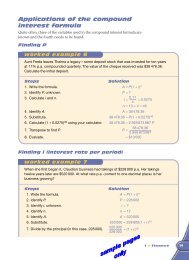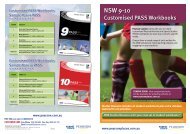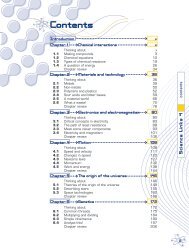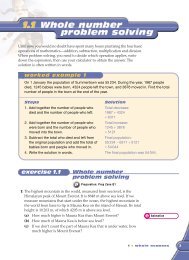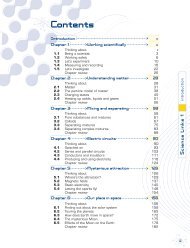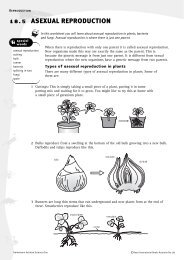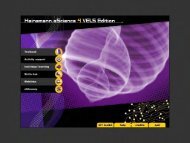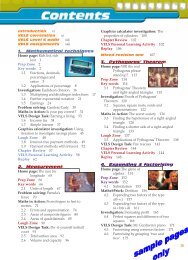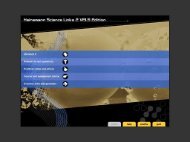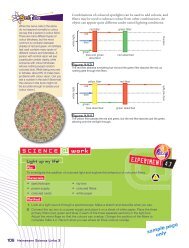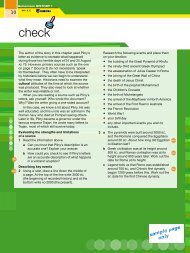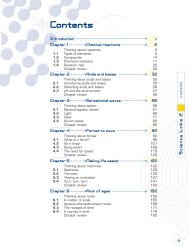Chapter 7 ENDANGERED SPECIES
Chapter 7 ENDANGERED SPECIES
Chapter 7 ENDANGERED SPECIES
You also want an ePaper? Increase the reach of your titles
YUMPU automatically turns print PDFs into web optimized ePapers that Google loves.
<strong>ENDANGERED</strong><br />
chapter<br />
7<br />
<strong>SPECIES</strong>: SAVING OUR FUTURE<br />
What is the man<br />
without the<br />
beasts?<br />
If all the beasts were<br />
gone, man would die from<br />
a great loneliness of the<br />
spirit.<br />
For whatever happens<br />
to the beasts, soon<br />
happens to man.<br />
Attributed to Chief Seattle,<br />
1784–1866 Chief of the Duwamishand<br />
Suquamish tribes, USA<br />
learn ABOUT<br />
• the habitats of<br />
endangered species<br />
• the threats to their<br />
survival<br />
• what you can do to<br />
help.<br />
learn TO<br />
What do you know about <strong>ENDANGERED</strong> <strong>SPECIES</strong>?<br />
In pairs, decide whether these statements are TRUE or<br />
FALSE. Briefly explain your answers, and compare them<br />
with others in the class.<br />
1 Grey Nurse sharks spew out their stomachs.<br />
2 Snow leopards prey on blue sheep.<br />
3 Grey Nurse sharks are near the bottom of the food chain.<br />
4 African elephants can eat the weight of three grown men<br />
each day.<br />
PL<br />
• interpret maps and<br />
statistics<br />
• use information<br />
technology to present<br />
your ideas and fi ndings<br />
• communicate using<br />
role play, class debate,<br />
a campaign.
154<br />
Heinemann HUMANITIES 1<br />
Endangered species – an overview<br />
Figure 1<br />
More than 12 000 of the world’s animal species<br />
face extinction. This means they have so few<br />
numbers they cannot reproduce enough to<br />
survive as a species. In this unit, you will enter their<br />
habitats, you will discover why they are endangered<br />
and fi nd out what people and organisations around<br />
the world are doing to save them.<br />
Snow leopard.<br />
African elephants.<br />
Map 1<br />
Grey Nurse shark.<br />
A r c t i c<br />
O c e a n<br />
A r c t i c C i r c l e<br />
2<br />
2<br />
7<br />
8<br />
9<br />
17<br />
P a c i f i c<br />
A t l a n t i c<br />
T r o p i c o f C a n c e r<br />
8<br />
6<br />
10<br />
O c e a n<br />
O c e a n<br />
E q u a t o r<br />
3<br />
12<br />
1<br />
T r o p i c o f C a p r i c o r n<br />
13<br />
4<br />
I n d i a n<br />
4<br />
14<br />
5<br />
10<br />
18<br />
11<br />
0<br />
1000<br />
2000<br />
17<br />
3000 4000 5000 km<br />
O c e a n<br />
17<br />
N<br />
15 16<br />
17 17<br />
There are endangered species all over the world. 1 Cheetah; 2 Grey Wolf; 3 Gorilla; 4 Orangutan; 5 Bird of<br />
Paradise; 6 Giant Panda; 7 Przewalski’s Horse; 8 Tiger; 9 North American Bison; 10 Jaguar; 11 Macaw;<br />
12 African Elephant; 13 Aye Aye; 14 Greater Bilby; 15 Helmeted Honeyeater; 16 Pygmy Possum; 17 Whales;<br />
18 Giant Brazilian Otter. (Source: Heinemann Atlas Third Edition.)
<strong>Chapter</strong> 7 <strong>ENDANGERED</strong> <strong>SPECIES</strong><br />
155<br />
HOW <strong>ENDANGERED</strong>? Each year, animals and plants are classifi ed on the ‘Red List’,<br />
published by the World Conservation Union, according to the degree of endangerment<br />
of extinction they face. This list defi nes the various levels:<br />
extinct<br />
extinct in the wild<br />
critically endangered<br />
endangered<br />
vulnerable<br />
near threatened<br />
data deficient (DD)<br />
The last individual of the species has died.<br />
All surviving members of the species exist in a cultured or captive environment.<br />
The species has an extremely high risk of extinction in the wild.<br />
The species faces a very high risk of extinction in the wild.<br />
The species faces a high risk of extinction in the wild.<br />
The species is likely to qualify for a higher category in the near future.<br />
There is inadequate data to classify the species.<br />
Extract 1<br />
Dirty old bags<br />
[Plastic bags] are lethal to marine life [as they]<br />
kill livestock and trap birds. According to<br />
Planet Ark, an international environmental<br />
group that has taken a leading role in the push<br />
to reduce plastic bag use, at least 100 000 birds,<br />
whales, seals and turtles are killed by plastic<br />
bags each year worldwide.<br />
Plastic bags cannot be digested or passed by an animal<br />
— they stay in the gut, causing pain and certain death.<br />
When dead animals decay, the bags are freed and often<br />
eaten again by other animals for many years to come …<br />
Many countries around the world have implemented<br />
measures to curb the use of plastic bags. Ireland …<br />
has placed a levy equivalent to 27 cents [on each bag,<br />
reducing] single-use plastic bag consumption by 90–95<br />
per cent over one year …<br />
Sushi Das, the Age (29 June 2004).<br />
activities<br />
G Investigating environmental issues<br />
1 Create a thermometer chart showing the<br />
degrees of endangerment from high to<br />
low. Use the Internet and library to find<br />
one endangered animal at each point of<br />
endangerment, and add them to your chart.<br />
2 Use Map 1 and the information on page<br />
180 to identify which continent seems<br />
to have the most endangered species.<br />
Compare the results and suggest why this<br />
might be the case.<br />
G Evaluating and presenting information<br />
3 There are many reasons why animals<br />
become endangered. In small groups,<br />
consider the following reasons and order<br />
them from the most likely to the least<br />
likely reason. Add some reasons of your<br />
own and share your views with the class.<br />
• hunting and killing<br />
• zoo collections<br />
• loss of habitat<br />
• pollution<br />
• domestication of wild animals<br />
• feral cats<br />
• overfishing<br />
• wild animals on restaurant menus<br />
4 Read Extract 1 then do the following<br />
activities:<br />
a List the information in this article which<br />
you think is factual.<br />
G Communication: writing a formal letter<br />
b As a class, write a letter to your local<br />
council urging them to pass a bylaw<br />
to ban free plastic bags in all<br />
stores. You could add a petition with<br />
signatures from people in your area.<br />
ICT<br />
T<br />
InD<br />
Com
156<br />
Heinemann HUMANITIES 1<br />
The Grey Nurse: 300 and counting<br />
AUSTRALIA<br />
NEW<br />
SOUTH<br />
WALES<br />
Sydney<br />
0 5km<br />
Map 1<br />
Sydney<br />
South Maroubra<br />
Magic Point<br />
Map of Australia, including Magic Point at South<br />
Maroubra.<br />
It is 8 a.m. The chilly wind sprays icy<br />
sea-water into my face as we bounce<br />
across a slight swell towards Magic<br />
Point at South Maroubra. I had wanted<br />
to do a night dive because that’s when the<br />
Grey Nurse feeds, and it’s a lot more exciting,<br />
especially with an underwater scooter and a<br />
spotlight. But Jane, the dive instructor, was<br />
horrifi ed: ‘No! We’re not allowed to dive there<br />
at night, we can’t use scooters, we can’t block<br />
the entrance to their caves, we can’t touch<br />
them or feed them, we can’t even interrupt<br />
their swimming patterns. We can only go<br />
down there to watch!’<br />
Oh well, it’s probably too scary at night<br />
anyway.<br />
It’s hard to believe we are less than twenty<br />
kilometres from central Sydney and yet so<br />
close to a colony of Grey Nurse sharks. Now<br />
by Meg Davis<br />
down<br />
that we are in the boat with open ocean in<br />
front of us, I’m glad she set the rules — rules<br />
to protect the sharks, not me!<br />
‘Three hundred and counting down,’ Jane<br />
shouts in my ear as we speed across the waves.<br />
I must have looked puzzled because she adds,<br />
‘There are only about three hundred Grey<br />
Nurses left, and we’re going to see nine of<br />
them.’<br />
I have been scuba diving before but this<br />
is going to be special. I’m itching to get into<br />
the water. We gear up and roll backwards<br />
into the cool blue sea. Visibility is great.<br />
Swimming down the anchor line, we reach<br />
the ocean fl oor about fi fteen metres below the<br />
surface. It’s only a short swim to a wide cave<br />
about two metres high: the home to a colony<br />
of Grey Nurse sharks. Grey Nurses love caves<br />
and deep trenches; they’ve been known<br />
to go down as deep as two hundred metres<br />
looking for food. They’re at the top of the food<br />
chain, so who knows what will happen if they<br />
become extinct.<br />
Several dark, silent fi gures — the largest<br />
almost four metres long, the smallest one<br />
metre — swim slowly round and round,<br />
patrolling the entrance to their cave.<br />
These sharks are beautifully streamlined,<br />
grey to bronze on top with white underbellies.<br />
The young ones have reddish spots on the<br />
lower part of their back but these fade as<br />
they get older. Row after row of backwardpointing,<br />
needle-like teeth fi ll their jaws.<br />
They look ferocious, but I’ve been promised<br />
they’re not.<br />
‘They’ll leave you alone as long as you don’t<br />
provoke them or get in the way when they’re<br />
feeding,’ Jane had said.
The Grey Nurse shark<br />
<strong>Chapter</strong> 7 <strong>ENDANGERED</strong> <strong>SPECIES</strong><br />
157<br />
Figure 1 Figure 2<br />
A food chain<br />
Fishers<br />
Large fish (e.g. sharks)<br />
Small fish (e.g. whiting)<br />
Small invertebrates (e.g. prawns)<br />
carbon dioxide + water<br />
sugars + oxygen + energy<br />
Producers (e.g. algae, mangroves)<br />
Energy from the Sun<br />
The Grey Nurse shark food chain.<br />
A Grey Nurse shark.<br />
activities<br />
Survival of the fittest<br />
The female Grey Nurse has a uterus on each<br />
side of her body. Each uterus contains several<br />
babies but usually only one from each uterus<br />
emerges alive. The pups are about one metre<br />
long at birth.<br />
Hooked!<br />
If a Grey Nurse is hooked and then brought to<br />
the surface too quickly, the air in its stomach<br />
will expand because of the lower pressure. This<br />
causes the gut wall to rupture, which, if left<br />
untreated, will cause the shark to die a painful<br />
death within a week or so, due to peritonitis<br />
(infl ammation of the peritoneum).<br />
1 From the story and photos in this unit,<br />
draw and colour a Grey Nurse shark,<br />
labelling key features.<br />
G Presenting geographical information<br />
using a diagram<br />
2 Look at Figure 2. In pairs, produce a food<br />
chain with sketches and labels. Illustrate<br />
and explain what might happen to the food<br />
chain if the Grey Nurse became extinct.<br />
3 Read Survival of the fittest and suggest<br />
how this reproductive method aids in the<br />
survival of the species.<br />
4 The scientific name of the shark<br />
commonly known as the Grey Nurse is<br />
Carcharias taurus; the family name is<br />
Odontospidae.<br />
a Using a dictionary or the Internet, find<br />
out what these Latin words mean.<br />
b How do these relate to the description<br />
of the Grey Nurse?<br />
5 Read Hooked! Find out the meaning of<br />
‘peritonitis’ and research its effects.<br />
Com<br />
Com<br />
T<br />
ICT<br />
T
182<br />
Heinemann HUMANITIES 1<br />
check<br />
T<br />
Com<br />
T<br />
1 Write down statements a to g. Write ‘true’<br />
next to any statements you feel are correct<br />
and ‘false’ next to those you feel are incorrect.<br />
Justify your choices. Two examples have been<br />
provided for you.<br />
Humans are one of the many threats<br />
to endangered species. True. Pollution,<br />
poaching, farming, overfishing and habitat<br />
destruction all contribute to the decline of<br />
species’ numbers.<br />
Because sharks are the perfect killing<br />
machine the Grey Nurse Shark will never<br />
die out. False. The Grey Nurse does not<br />
reproduce quickly, is hunted by humans, its<br />
natural habitat is being destroyed and its<br />
numbers are declining already.<br />
a Snow leopards are only endangered in<br />
Nepal.<br />
b Vulnerable species are not as threatened as<br />
critically endangered species.<br />
c Female African elephants are pregnant for<br />
about two years.<br />
d Grey Nurse sharks are at the top of their<br />
food chain.<br />
e Mount Kilimanjaro is in South Africa.<br />
f Snow leopards sold on the black market<br />
bring in very little money.<br />
g Farmers pose very little threat to the African<br />
elephant.<br />
2 Construct food chains that include the three<br />
endangered species, their predators and prey.<br />
3 Imagine you are a worker for the WWF. List the<br />
five things that would be your priorities once<br />
you started work.<br />
4 What value do conservation groups have in<br />
today’s society? Do you think that they and<br />
their aims and objectives are worthwhile or a<br />
waste of public resources and money?<br />
5 Imagine you are living 100 years in the future.<br />
Create a written, oral or visual presentation to<br />
answer the following questions.<br />
a Which endangered species might still and<br />
might not exist and why?<br />
b You open up a time capsule from 2006,<br />
which gives details about what was being<br />
done to protect endangered species. List<br />
what you would find.<br />
c Predict how you think future society might<br />
protect endangered species.<br />
6 Design a poster showing why we should<br />
protect not just endangered species but all<br />
species.<br />
7 A number of Australian species are on the Red<br />
List. Create a written, oral or visual presentation<br />
to outline the impact that the extinction of such<br />
animals as the koala, the northern hairy-nosed<br />
wombat, the wedge-tailed eagle or the Grey<br />
Nurse shark would have on Australia.<br />
T<br />
T<br />
T<br />
Com<br />
Com
<strong>Chapter</strong> 7 <strong>ENDANGERED</strong> <strong>SPECIES</strong><br />
WB • G, H, J, I, C, D, E<br />
TRK • FW, ET, CT, AT<br />
CD • MG, MC, RW, AQ, FG<br />
183<br />
PL<br />
time to refl ect<br />
1 a Which part of this unit made you feel you<br />
would like to learn something about an<br />
endangered species?<br />
b We all learn in different ways. Which activity<br />
in this unit suited your learning style best?<br />
Which activity did you most enjoy?<br />
2 List the things you would add or drop from this<br />
unit. Give reasons for your suggestions.<br />
4 Suggest an additional activity (draw something,<br />
investigate, hear a speaker, etc.) you would<br />
like to be included in a study of endangered<br />
species.<br />
5 a Explain the value of doing fieldwork on<br />
endangered species.<br />
b What sort of fieldwork would you suggest?<br />
Explain.<br />
6 What aspects of learning about endangered<br />
species are valuable to society in general?<br />
3 Suggest two other species not included in this<br />
unit that you would like to study. Give reasons.
184<br />
Heinemann HUMANITIES 1<br />
glossary<br />
alpine the mountain environment<br />
bull a male elephant<br />
carcass the body of a dead animal<br />
cow a female elephant<br />
critical habitat a habitat that is essential for the<br />
survival of a species<br />
critically endangered facing an extremely high risk<br />
of extinction in the wild<br />
data deficient (DD) inadequate data is available<br />
domestication the adaptation of an animal for use<br />
by humans; taming<br />
dry season the time of the year when there is little<br />
rain<br />
electroreception the sense that allows sharks to<br />
detect very weak electrical currents<br />
endangered facing a very high risk of extinction in<br />
the wild<br />
exterminate to get rid of something by completely<br />
destroying it<br />
extinct no longer existing<br />
extinct in the wild only surviving in a cultured or<br />
captive environment<br />
feral wild or untamed<br />
food chain a chain of organisms indicating which<br />
living things are eaten by others<br />
gestation the period of time needed to produce a<br />
living offspring<br />
habitat the area and its surroundings in which a<br />
species lives<br />
herd a large group of four-legged animals of a<br />
single species<br />
Himalayas the mountain chain in south-central<br />
Asia (including Mount Everest and nine of the<br />
world’s ten-highest peaks) that extends for about<br />
2414 km<br />
ibex a mountain sheep that lives in the Himalayas<br />
ivory hard whitish dentine (tooth material) of which<br />
animals’ tusks are made<br />
national park an area of land set aside by a<br />
government for the conservation of natural features<br />
near threatened likely to qualify for a category of<br />
endangerment in the near future<br />
offspring a descendant of an animal or plant<br />
peritonitis inflammation of the peritoneum, the<br />
membrane that lines the stomach walls<br />
poaching illegal hunting or fishing<br />
ranger a person who is employed to protect areas<br />
such as national parks<br />
sanctuary a place which provides protection of<br />
wildlife<br />
savannah an area characterised by grasslands and<br />
scattered trees, and having a wet season and a dry<br />
season<br />
scavenger an animal that feeds on dead or<br />
decaying matter<br />
species a class of organisms that are grouped<br />
because they have common attributes<br />
steel tracer steel used for the first 2 metres of<br />
a fishing line, near the hook, to avoid having the<br />
rough skin of a shark break the line<br />
strychnine a poison that affects the nervous<br />
system, and usually leads to a slow and painful<br />
death<br />
trench a long, steep-sided valley on the ocean<br />
floor.<br />
uterus the cavity in the bodies of some female<br />
animals in which offspring develop before birth<br />
vulnerable facing high risk of extinction in the wild<br />
whistleblower a person who informs authorities of<br />
an illegal activity<br />
Place chapter opening photo here and increase photo<br />
height to start 5mm from last line of glossary text. Photo<br />
must remain this width, it is ok for the photo to be<br />
cropped.



